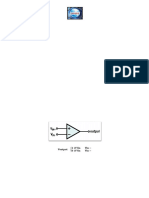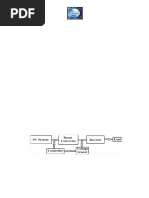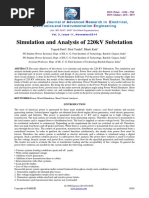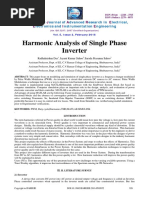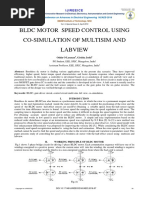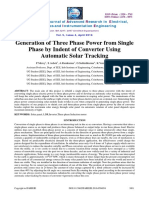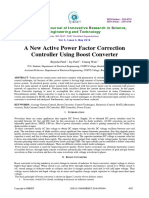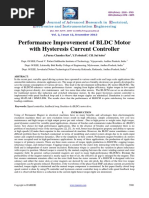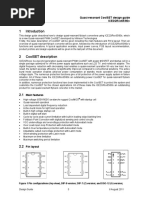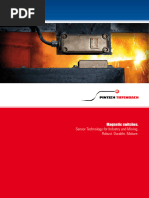Design of Low Power High Speed Dynamic Comparator
Design of Low Power High Speed Dynamic Comparator
Uploaded by
RatnakarVarunCopyright:
Available Formats
Design of Low Power High Speed Dynamic Comparator
Design of Low Power High Speed Dynamic Comparator
Uploaded by
RatnakarVarunOriginal Title
Copyright
Available Formats
Share this document
Did you find this document useful?
Is this content inappropriate?
Copyright:
Available Formats
Design of Low Power High Speed Dynamic Comparator
Design of Low Power High Speed Dynamic Comparator
Uploaded by
RatnakarVarunCopyright:
Available Formats
ISSN (Print) : 2320 – 3765
ISSN (Online): 2278 – 8875
International Journal of Advanced Research in Electrical,
Electronics and Instrumentation Engineering
(An ISO 3297: 2007 Certified Organization)
Website: www.ijareeie.com
Vol. 6, Issue 6, June 2017
Design of Low Power High Speed Dynamic
Comparator
N.Gowtham Kumar1, B.Srinivas2
PG Student [VLSI], Dept. of ECE, MVGR College of Engineering (A), Vizianagaram, Andhra Pradesh, India1
Assistant Professor, Dept. of ECE, MVGR College of Engineering (A), Vizianagaram , Andhra Pradesh, India2
ABSTRACT:In this paper, a high-speed low-power two-stage dynamic latched comparator is proposed. In this
proposed circuit the first stage power consumption is lessen by limiting the pre-amplifier's voltage swing to Vdd/2 At
the evaluation phase, voltage swing constraint provides a vigorous drive which improves comparison speed.. It is
shown that in the proposed dynamic latched comparator have less dissipated power and time delay. The proposed
dynamic latched comparator reduced the power and delay compared to conventional CMOS comparators. Finally the
comparator mentor graphics simulation at the 130nm gives significant improvement in the power and delay.
KEYWORDS:Two stage dynamic comparator, window detector, low power applications.
I.INTRODUCTION
All After Op Amp comparators are mostly used electronic component because they play an important role in ADC’s.
Comparators are also called as 1-bit A/D convertor. In past Static comparators are used but they are low speed and a
large amount of power consumption, due these drawbacks this type of comparator are not applicable for the portable
devices. The drawbacks of the static comparator are overcome using dynamic comparator. Initially come up with single-
stage dynamic comparators, to increase speed and to reduce the power consumption. But these comparators are suffers
with kick back noises which is caused due to the capacitive path formed between output and input. Two-stage dynamic
latched comparators are introduced, the drawback of the one-stage dynamic comparator are overcome. To attain the
given offset the two-stage dynamic comparator’s transistor at the input side are chosen large. There will be larger
parasitic capacitance at the output terminal of the first stage of comparator because of using large transistor at input. Due
to this power consumption influences offset, as power consumption reduces offset increases. There are number of
techniques have been proposed to reduce power dissipation and increase speed. Advantages and disadvantages of each
technique are explained below.
A conventional two-stage dynamic comparator [13] is high speed, but to achieve low offset voltage transistor size is
increase as a result the power consumption is increase. So this conventional two-stage comparator is not suitable for low
power applications.
In [7] a two stage comparator which works only with one clock phase. In this low offset voltage is achieved by using
time domain tuned offset cancelation technique is deployed. Smaller transistors are used due to low offset voltage, so the
power consumption will reduce. But speed of the comparator is limited due these techniques.
In [6] also two-stage dynamic comparators with different structure which have higher speed but larger power
consumption. Power dissipation is large for all these comparators. The proposed two-stage dynamic comparator structure
has less stacking and faster latching.
The paper is systemized as follows. Section 2 explores about the dynamic-latch comparator, new dynamic comparator
architecture and its operation is described in Section 3. Section 4 discusses the architecture of window detector.
Simulation results and conclusion are provided in Section 5 and Section 6 respectively.
Copyright to IJAREEIE DOI:10.15662/IJAREEIE.2017.0606040 4471
ISSN (Print) : 2320 – 3765
ISSN (Online): 2278 – 8875
International Journal of Advanced Research in Electrical,
Electronics and Instrumentation Engineering
(An ISO 3297: 2007 Certified Organization)
Website: www.ijareeie.com
Vol. 6, Issue 6, June 2017
clock pulse
input signal pre amplifier stage latch stage output
reference voltage
Fig. 1 block diagram of dynamic latched comparator.
II.CLASSIFICATION OF COMPARATOR
Comparators are classified into various types. Those are described below.
A. Static Latched Comparators
The first classification is static latched comparator. An example of static latched comparator is shown in below figure
2. The common characteristics of the static latched comparator are summarized as
By the two class-A cross coupled inverters (M3a/M4aand M3b/M4b) regeneration process is done. But the
regeneration process is slow due to current limited operation by the class A cross coupled inverter. Because of
the consumption is purely static, power efficiency is poor.
A differential pair which acts as preamplifier, the output current of this preamplifier is mirrored or injected in
the regenerative nodes through the cascade transistor. Kickback noise reduced by this isolation. But it
introduces two poles at intermediate node and regeneration nodes respectively.
Fig. 2 Static latched comparator
In practical, these latched comparators are not used due to the process of regeneration is slow and static power.Even
though a low kickback noise is presented.
Copyright to IJAREEIE DOI:10.15662/IJAREEIE.2017.0606040 4472
ISSN (Print) : 2320 – 3765
ISSN (Online): 2278 – 8875
International Journal of Advanced Research in Electrical,
Electronics and Instrumentation Engineering
(An ISO 3297: 2007 Certified Organization)
Website: www.ijareeie.com
Vol. 6, Issue 6, June 2017
B. Class-AB latched comparators
Second type is Class-AB latched comparator, speed limitation problem of above latched comparator is achieved by this
type of comparator. Example of Class-AB latched comparator is shown in figure 3. Common characteristics are as
follows.
Cross coupled CMOS inverters will do regeneration process. The output nodes are charged faster by
momentarily increase of current during the regeneration process.
There will be one pole exists in this type of comparator because there is no isolation between input differential
pair drains and regeneration nodes, so it reacts quickly to the input variations. However kick back noise is
increases due to the rail to rail signals at nodes which are coupled to inputs.
Fig. 3 Class AB latched comparator
Even though it is fast and power efficientwhen compared to static comparator, it not used because more kick back noise
isthe drawback of these comparators.
C. Dynamic comparators
Class AB latched comparator is more power efficient, still it uses supply current during reset phase.Dynamic
comparators are also called as clocked comparators.A regenerative feedback is used in dynamic comparators to achieve
low power, high speed, full output swing and high gain. Power is consumed during the evaluation phase.Speed of the
dynamic comparators is very high and the power dissipation is low.
III.TWO STAGE DYNAMIC COMPARATORS
The dynamic comparator[2] shown in figure4 is a conventional one, when the clock is set high M18, M8, M11,M12
AND M14 are turned on, and M5-M10 pmos transistor are turned off. M17 is connected to one of the input pair, it
conducts a constant current which intentionally create a additional offset voltage. This conventional comparator is high
speed but it stable only under small disturbances.
Another type of comparator [1] is shown in figure5. It consists of two stages: preamplifier stage and latch stage. Before
to start comparison, the comparator state is reset to discharge the output node of preamplifier and latch stage to ground
and VDD respectively. In next phase the evaluation phase clock to 0 and clockbar to 1 to start comparison. The output of
the preamplifier increases, when the output voltage of preamplifier stage is approach the gate voltage of input NMOS
transistor of latch, the latch stage of the comparator is activated. To control offset, the input transistors’ size are
increased. But large size transistor increases the power consumption. Due to this comparator is not suitable of low power
high resolution applications.
Copyright to IJAREEIE DOI:10.15662/IJAREEIE.2017.0606040 4473
ISSN (Print) : 2320 – 3765
ISSN (Online): 2278 – 8875
International Journal of Advanced Research in Electrical,
Electronics and Instrumentation Engineering
(An ISO 3297: 2007 Certified Organization)
Website: www.ijareeie.com
Vol. 6, Issue 6, June 2017
Fig. 4conventional dynamic comparator
Fig. 5 comparator 2
IV.PROPOSED COMPARATOR
The proposed comparator is shown in figure6. This comparator can be operated at lower voltage because this circuit has
less stacking. Independent on common mode voltage, the M12 transistor conducts larger current, which provide speed to
comparator. Initially, the comparator state is reset. During the resetphase clk = 0 the output node voltage of preamp are
discharged to vdd\2. M1, M8 transistor will turn on, and output discharges to ground(0).
After reset phase clk is vdd, the first stage output voltage starts growing gradually. Magnitude of input differential
voltage affects the growth rate of output voltage of first stage. When it reaches threshold voltage of the NMOS
transistors’ (M7, M8), the latch stage is activated. An additional shield is formed between input and output by the cross
coupled transistor. This provides less kickback noise.Output waveform and layout of the comparator are shown in below
figure 7 figure 8 respectively.
Copyright to IJAREEIE DOI:10.15662/IJAREEIE.2017.0606040 4474
ISSN (Print) : 2320 – 3765
ISSN (Online): 2278 – 8875
International Journal of Advanced Research in Electrical,
Electronics and Instrumentation Engineering
(An ISO 3297: 2007 Certified Organization)
Website: www.ijareeie.com
Vol. 6, Issue 6, June 2017
Fig. 6 proposed dynamic comparator
Fig. 7 waveform of the proposed comparator
Fig.8 layout of proposed comparator
Copyright to IJAREEIE DOI:10.15662/IJAREEIE.2017.0606040 4475
ISSN (Print) : 2320 – 3765
ISSN (Online): 2278 – 8875
International Journal of Advanced Research in Electrical,
Electronics and Instrumentation Engineering
(An ISO 3297: 2007 Certified Organization)
Website: www.ijareeie.com
Vol. 6, Issue 6, June 2017
V.APPLICATION
Window Detector:
Window detector is also called as window comparator or dual edge limit detector. It has two precise reference voltages,
an upper limit and a lower limit. If vin is the input voltage, v1 is upper limit and v2 is lower limit, whenever the vin is
between the v1 and v2 output will obtain. Window detector consists of two comparators, output of the two comparator
are connected to two inputs AND gate.
Fig. 9 block diagram of window detector
Window detector is employed in a varity of applications. Window detector is used as input stage for low power SAR
ADC in biomedical applications, industrial alarms, level sensor. The waveform of window detector is shown below
whenever the input is lies between the two limit the output will follow the clock.
Fig. 10 schematic of the window detector
.
Fig. 11 waveform of window detector
Copyright to IJAREEIE DOI:10.15662/IJAREEIE.2017.0606040 4476
ISSN (Print) : 2320 – 3765
ISSN (Online): 2278 – 8875
International Journal of Advanced Research in Electrical,
Electronics and Instrumentation Engineering
(An ISO 3297: 2007 Certified Organization)
Website: www.ijareeie.com
Vol. 6, Issue 6, June 2017
In output wave form of the window detector is shown in the figure 11. We can observe that the output follows the clock
when the input wave form is between the top reference value and bottom reference value. Figure 12 shown below is the
layout of the window detector.
Fig. 12 layout of window detector
VI.SIMULATION RESULTS
The proposed comparator 130nm CMOS dynamic latch comparator and existing dynamic latch comparators are design
and simulated in mentor graphics with 1V supply. Comparing the proposed and other comparators are tabulated below
table1. Table 2 summarizes the performance of the window detector implemented using proposed comparator.
Table 1: comparison table of proposed comparator with other comparator.
Specification Comparat Comparator Proposed
or -1 -2 comparator
Technology 130nm 130nm 130nm
Supply voltage 1V 1V 1V
Number of 16 15 13
transistors
Delay 5.2974ns 948.85ps 453.2ps
Power 1.8497nw 4.9153nw 1.7995n
dissipation
Table 2: performance of window detector.
Specification Window detector
Technology 130nm
Supply voltage 1V
Delay 30.6ns
Power dissipation 8.874nwatts
Copyright to IJAREEIE DOI:10.15662/IJAREEIE.2017.0606040 4477
ISSN (Print) : 2320 – 3765
ISSN (Online): 2278 – 8875
International Journal of Advanced Research in Electrical,
Electronics and Instrumentation Engineering
(An ISO 3297: 2007 Certified Organization)
Website: www.ijareeie.com
Vol. 6, Issue 6, June 2017
VII.CONCLUSION
In this work, a two stage dynamic comparator has been proposed for low swing application. From the simulation results
it has power dissipation of 1.7995nwatts and delay of 453.2ps The simulated results imply that proposed comparator
achieves low power consumption and less delay. The performance of window detector is also increased by using the
proposed comparator.
REFERENCES
[1] Ata Khorami , Mohammad Sharifkhani, “High-speed low-power comparator for analog to digital converters,” Int. J. Electron. Commun., Vol.
70, pp. 886–894, 2016.
[2] Chin-Yu Lin, Chien-HengWong, Chia-Hau Hsu, Yen-Hsin Wei, and Tai-Cheng Lee, “A 200-MS/s Phase-Detector-Based ComparatorWith
400-μVrms Noise,” IEEE Transactions on circuits and systems, Vol. 63, no. 9, 2016.
[3] Khorami A, Sharifkhani M, “One-dimensional adiabatic circuits with inherentcharge recycling,” Electron Lett, Vol. 51, no. 14, pp. 7–9, 2015.
[4] Gao Junfeng, Li Guangjun, Li Qiang, “High-speed low-power common-mode insensitive dynamic comparator,” Electron Lett., Vol. 51, no. 2,
pp. 134-136, 2015.
[5] Hassanpourghadi Mohsen, Zamani Milad, Sharifkhani Mohammad, “A lowpower low-offset dynamic comparator for analog to digital
converters,” Microelectron J, Vol. 45, no. 2, pp. 256-262, 2014.
[6] D’Amico S, Cocciolo G, Spagnolo A, De Matteis M, Baschirotto A,“A 7.65-mW 5- bit 90-nm 1-Gs/s folded interpolated ADC without
calibration,” IEEE TransInstrum Meas, Vol. 63, no. 2, pp. 295-303, 2014.
[7] Lu Junjie, Holleman J, “A low-power high-precision comparator with timedomainbulk-tuned offset cancellation,” IEEE Trans Circuits Syst
I,Vol. 60, no. 5, pp. 1158-1167, 2013.
[8] Abbas M, Furukawa Y, Komatsu S, Takahiro JY, Asada K, “Clocked comparator for high-speed applications in 65nm technology,” In: Solid
state circuits conference(A-SSCC), pp. 1-4, 2010.
[9] Johns David A, Martin Ken,“Analog integrated circuit design,” John Wiley &Sons, 2008.
[10] Figueiredo PM, Vital JC, “ Kickback noise reduction techniques for CMOS latched comparators,” IEEE Trans Circuits Syst II, Vol. 53, no. 7,
pp. 541-545, 2006.
[11] Nikoozadeh A, Murmann B, “An analysis of latch comparator offset due to load capacitor mismatch,” IEEE Trans Circuits Syst II, Vol. 53, no.
12, pp. 1398-1402, 2006.
[12] Wicht B, Nirschl T, Schmitt-Landsiedel D, “Yield and speed optimization of a latch-type voltage sense amplifier,” IEEE J Solid-State Circuits,
Vol. 39, no. 7, pp. 1148-1158, 2004.
[13] Cho TB, Gray PR., “ A 10 b, 20 Msample/s, 35 mW pipeline A/D converter,” IEEE J Solid-State Circuits, Vol. 30, no. 3, pp. 166-172, 1995.
Copyright to IJAREEIE DOI:10.15662/IJAREEIE.2017.0606040 4478
You might also like
- ADC Verification RAKDocument208 pagesADC Verification RAKSatyam YadavNo ratings yet
- 62 DesignDocument8 pages62 DesignRahul SinghNo ratings yet
- 38 Determination PDFDocument6 pages38 Determination PDFriccardo tarelliNo ratings yet
- New Invention in Converting Two Phase To Three Phase Employing An Induction MachineDocument7 pagesNew Invention in Converting Two Phase To Three Phase Employing An Induction MachineJeff's SKiNo ratings yet
- 19 - Final Paper-E61212607Document14 pages19 - Final Paper-E61212607Cássio Lázaro de AguiarNo ratings yet
- IJAREEIE NithinDocument12 pagesIJAREEIE Nithinsreekala krishnanNo ratings yet
- Field Oriented Control of Permanent Magnet PDFDocument8 pagesField Oriented Control of Permanent Magnet PDFLê Đức ThịnhNo ratings yet
- Speed and Direction Control of DC Motor Without Using MicrocontrollerDocument5 pagesSpeed and Direction Control of DC Motor Without Using MicrocontrollerNitesh ChaurasiyaNo ratings yet
- Implementation of High Speed 0.13 M CMOS Dynamic Latch ComparatorDocument3 pagesImplementation of High Speed 0.13 M CMOS Dynamic Latch ComparatorijsretNo ratings yet
- 39 A SensorlessDocument8 pages39 A SensorlessANUSHA NAIDUNo ratings yet
- Speed Control of BLDC Motor Using PID Controller: I J A R E E I EDocument5 pagesSpeed Control of BLDC Motor Using PID Controller: I J A R E E I EAhmed ShoeebNo ratings yet
- Design and Analysis of Double Tail Comparator Using Adiabatic LogicDocument7 pagesDesign and Analysis of Double Tail Comparator Using Adiabatic LogicIJSTENo ratings yet
- International Journal of Advanced Research in Electrical,Document9 pagesInternational Journal of Advanced Research in Electrical,OSAMAH ABDULLAHNo ratings yet
- Simulation and Analysis of 220kV SubstationDocument8 pagesSimulation and Analysis of 220kV SubstationDavid PandayNo ratings yet
- 50APHASEDocument9 pages50APHASEswaathi selvakumarNo ratings yet
- Power Factor Correction of Single Phase Induction Motor Using PLCDocument8 pagesPower Factor Correction of Single Phase Induction Motor Using PLCAlvin Nugroho100% (1)
- Harmonic Analysis of Single Phase InverterDocument9 pagesHarmonic Analysis of Single Phase InverterBib SaNo ratings yet
- A Low Power and High Speed 45 NM CMOS Dynamic Comparator With Low OffsetDocument8 pagesA Low Power and High Speed 45 NM CMOS Dynamic Comparator With Low OffsetInternational Journal of Power Electronics and Drive SystemsNo ratings yet
- 18 VoltageDocument8 pages18 VoltageChayan MondalNo ratings yet
- BLDC Motor Speed Control Using Co-Simulation of Multisim and LabviewDocument5 pagesBLDC Motor Speed Control Using Co-Simulation of Multisim and LabviewJanet WaldeNo ratings yet
- Double Tail Latch ComparatorDocument5 pagesDouble Tail Latch ComparatorSayantan RoyNo ratings yet
- 54 1 GenerationDocument6 pages54 1 GenerationjolikayNo ratings yet
- Performance of Photovoltaic System's Maximum Power Point TrackingDocument8 pagesPerformance of Photovoltaic System's Maximum Power Point TrackingramezhosnyNo ratings yet
- A New Active Power Factor Correction Controller Using Boost ConverterDocument8 pagesA New Active Power Factor Correction Controller Using Boost ConverterLeonard Young-Khaled SendeNo ratings yet
- 3phase Ac-Dc - DesignDocument9 pages3phase Ac-Dc - DesignPavan Kumar A GNo ratings yet
- Design & Analysis of High Speed Low and Area CMOS Based Comparator With Different ArchitecturesDocument4 pagesDesign & Analysis of High Speed Low and Area CMOS Based Comparator With Different ArchitecturesijeteeditorNo ratings yet
- Design of A Low Power High Speed Double Tail ComparatorDocument5 pagesDesign of A Low Power High Speed Double Tail ComparatornandakishoryadavNo ratings yet
- Design and Simulation of Solar Micro-: Inverter With Multiple LoadsDocument9 pagesDesign and Simulation of Solar Micro-: Inverter With Multiple LoadsAwgichwAsefaNo ratings yet
- 32 Paper 60Document5 pages32 Paper 60shankul.saurabhNo ratings yet
- Chacko 2019Document4 pagesChacko 2019Milton VillcaNo ratings yet
- 19 - FinalPaper E61212607 1Document15 pages19 - FinalPaper E61212607 1MDLNo ratings yet
- Design and Implementation of Low Power and High Performance 0.13 M CMOS Dynamic Comparator For Analog To Digital ConverterDocument3 pagesDesign and Implementation of Low Power and High Performance 0.13 M CMOS Dynamic Comparator For Analog To Digital ConverterijsretNo ratings yet
- Design and Analysis of A High-Gain Dual-Input Single-Output DC-DC Converter For Hybrid Energy Systems ApplicationsDocument10 pagesDesign and Analysis of A High-Gain Dual-Input Single-Output DC-DC Converter For Hybrid Energy Systems ApplicationsInternational Journal of Power Electronics and Drive SystemsNo ratings yet
- Analysis of Output DC Current Injection in Grid Connected InvertersDocument7 pagesAnalysis of Output DC Current Injection in Grid Connected Invertersvineets058No ratings yet
- 18 - Three Phase InductionDocument7 pages18 - Three Phase InductiondevchandarNo ratings yet
- ICEEOTIEEEDocument6 pagesICEEOTIEEE21-202 Furqan Saleem MohammedNo ratings yet
- A Novel Power Quality Improvement Technique Using Multi-Connected Distributed Power Flow Controller (MC-DPFC)Document11 pagesA Novel Power Quality Improvement Technique Using Multi-Connected Distributed Power Flow Controller (MC-DPFC)Vijay KrishnaNo ratings yet
- Monitoring of Corrosions and Leakages in Gas Pipelines and A Safety Technique Using LabviewDocument7 pagesMonitoring of Corrosions and Leakages in Gas Pipelines and A Safety Technique Using LabviewSinn RavenNo ratings yet
- Transformer Less Voltage Quadrupler Based DC-DC Converter With Coupled Inductor and PI Filter For Increased Voltage Gain and EfficiencyDocument8 pagesTransformer Less Voltage Quadrupler Based DC-DC Converter With Coupled Inductor and PI Filter For Increased Voltage Gain and EfficiencywelsyaNo ratings yet
- 10 1 1 1062 5767 PDFDocument8 pages10 1 1 1062 5767 PDFfarid kerroucheNo ratings yet
- Don Bosco Institute of Technology: Department of Electronics and Communication EngineeringDocument23 pagesDon Bosco Institute of Technology: Department of Electronics and Communication EngineeringSeema Shekarappa ChittakkiNo ratings yet
- Final Review - 04Document22 pagesFinal Review - 04Dharanisree DNo ratings yet
- Performance Improvement of BLDC Motor With Hysteresis Current ControllerDocument8 pagesPerformance Improvement of BLDC Motor With Hysteresis Current ControllerRaja BalanNo ratings yet
- Simulation of Brushless DC Motor Speed Control in Matlab-Ijaerdv04i1290151Document7 pagesSimulation of Brushless DC Motor Speed Control in Matlab-Ijaerdv04i1290151Wairokpam DhanrajNo ratings yet
- A Review On Multiphase System For High: Power Industrial ApplicationsDocument7 pagesA Review On Multiphase System For High: Power Industrial ApplicationsRob LuciNo ratings yet
- Operation Analysis of Current Transformer With Transient Performance Analysis Using EMTP SoftwareDocument8 pagesOperation Analysis of Current Transformer With Transient Performance Analysis Using EMTP SoftwareJosNo ratings yet
- Irjet V4i5121 PDFDocument5 pagesIrjet V4i5121 PDFAnonymous plQ7aHUNo ratings yet
- 50 Modeling AtsDocument9 pages50 Modeling Atst.benaissaNo ratings yet
- Design of High Performance Dynamic CMOS Circuits in Deep Submicron TechnologyDocument15 pagesDesign of High Performance Dynamic CMOS Circuits in Deep Submicron TechnologyEeshwar Ram JNo ratings yet
- Speed Control of DC Motor Using Hybrid Fuzzy-PID ControllerDocument6 pagesSpeed Control of DC Motor Using Hybrid Fuzzy-PID ControllerHazar JojoNo ratings yet
- EXPERIMENTAL_STUDY_ON_POWER_SAVER_ESTABLDocument7 pagesEXPERIMENTAL_STUDY_ON_POWER_SAVER_ESTABLelecenggNo ratings yet
- Leakage Power in CMOS and Its Reduction TechniquesDocument8 pagesLeakage Power in CMOS and Its Reduction Techniquesswams_suni647No ratings yet
- PV FED Interleaved Boost Converter For BLDC MotorDocument8 pagesPV FED Interleaved Boost Converter For BLDC MotorIJRASETPublicationsNo ratings yet
- Double Tail Dynamic CompDocument10 pagesDouble Tail Dynamic CompBhura AnushaNo ratings yet
- Design of Solid State On Load Tap ChangeDocument2 pagesDesign of Solid State On Load Tap ChangeaskinfoNo ratings yet
- SVPWM For 3-Phase 3-Level Neutral Point Clamped Inverter Fed Induction Motor ControlDocument9 pagesSVPWM For 3-Phase 3-Level Neutral Point Clamped Inverter Fed Induction Motor ControljamalNo ratings yet
- Analysis and Design of High Speed Low Power Comparator in ADCDocument6 pagesAnalysis and Design of High Speed Low Power Comparator in ADCNoReply ProgramNo ratings yet
- Control of SRM Using 3-Level Neutral Point Diode Clamped Converter With PI and Fuzzy ControllerDocument7 pagesControl of SRM Using 3-Level Neutral Point Diode Clamped Converter With PI and Fuzzy ControllerHarsha VardhanNo ratings yet
- 12 - 22 Bindhu RubiniDocument6 pages12 - 22 Bindhu RubiniHashimIdreesNo ratings yet
- Kamal 2020 J. Phys. Conf. Ser. 1529 052100Document10 pagesKamal 2020 J. Phys. Conf. Ser. 1529 052100Gazza TNo ratings yet
- Software Requirements: 3.1GENERALDocument24 pagesSoftware Requirements: 3.1GENERALRatnakarVarunNo ratings yet
- FemtoRV32 Piplined Processor ReportDocument25 pagesFemtoRV32 Piplined Processor ReportRatnakarVarunNo ratings yet
- Design of High Speed Multiplier UsingDocument68 pagesDesign of High Speed Multiplier UsingRatnakarVarun100% (1)
- A Partially Static High Frequency 18T Hybrid Topological Flip-Flop Design For Low Power ApplicationDocument5 pagesA Partially Static High Frequency 18T Hybrid Topological Flip-Flop Design For Low Power ApplicationRatnakarVarunNo ratings yet
- M.tech - Thesis SramsDocument69 pagesM.tech - Thesis SramsRatnakarVarunNo ratings yet
- VLSI-Latest Titles: S.No Project Code Project NameDocument10 pagesVLSI-Latest Titles: S.No Project Code Project NameRatnakarVarunNo ratings yet
- Calculator 1Document39 pagesCalculator 1RatnakarVarunNo ratings yet
- IEEE 2020-2021 VLSI Project TitilesDocument2 pagesIEEE 2020-2021 VLSI Project TitilesRatnakarVarunNo ratings yet
- Scalable Approach For Power Droop Reduction During Scan-Based Logic BistDocument9 pagesScalable Approach For Power Droop Reduction During Scan-Based Logic BistRatnakarVarunNo ratings yet
- Using Probability Distributions in R: Dnorm, Pnorm, Qnorm, and RnormDocument7 pagesUsing Probability Distributions in R: Dnorm, Pnorm, Qnorm, and RnormRatnakarVarunNo ratings yet
- LFSR-Based Generation of Multi Cycle TestsDocument9 pagesLFSR-Based Generation of Multi Cycle TestsRatnakarVarun100% (1)
- A Novel Approach To Multi Modal Hybrid Image Fusion Using Wavelet and Contourlet Transform For Medical Diagnosis ApplicationsDocument7 pagesA Novel Approach To Multi Modal Hybrid Image Fusion Using Wavelet and Contourlet Transform For Medical Diagnosis ApplicationsRatnakarVarunNo ratings yet
- Scalable Approach For Power Droop Reduction During Scan-Based Logic BISTDocument4 pagesScalable Approach For Power Droop Reduction During Scan-Based Logic BISTRatnakarVarunNo ratings yet
- Acceptance Letter in IJMETMR - Shaik Nabia & Shaik Iffath AnjumDocument1 pageAcceptance Letter in IJMETMR - Shaik Nabia & Shaik Iffath AnjumRatnakarVarunNo ratings yet
- College Format DocumentDocument74 pagesCollege Format DocumentRatnakarVarunNo ratings yet
- 1.1 Image Fusion:: Implement of Hybrid Image Fusion Technique For Feature Enhancement in Medical DiagnosisDocument105 pages1.1 Image Fusion:: Implement of Hybrid Image Fusion Technique For Feature Enhancement in Medical DiagnosisRatnakarVarunNo ratings yet
- Optimization of Fir Filters Using MCM and CSE Techniques: Pankaj Gupta, Mandeep KaurDocument9 pagesOptimization of Fir Filters Using MCM and CSE Techniques: Pankaj Gupta, Mandeep KaurRatnakarVarunNo ratings yet
- Compliance, Safety, Accountability (CSA) and Drivers: Spring 2017Document20 pagesCompliance, Safety, Accountability (CSA) and Drivers: Spring 2017RatnakarVarunNo ratings yet
- Pulsed LatchesDocument83 pagesPulsed LatchesRatnakarVarun100% (1)
- Bit-Level Optimization of Adder-TreesDocument49 pagesBit-Level Optimization of Adder-TreesRatnakarVarunNo ratings yet
- Bhavya Paper NewDocument6 pagesBhavya Paper NewRatnakarVarunNo ratings yet
- 314324-DIGITAL ELECTRONICS AND MICROCONTROLLER APPLICATIONSDocument8 pages314324-DIGITAL ELECTRONICS AND MICROCONTROLLER APPLICATIONSyogi_mahaNo ratings yet
- Tessent Scan (Dftadvisor) : Why The Clock Inputs On Some D Flop Flops Are Assigned Uo Faults?Document3 pagesTessent Scan (Dftadvisor) : Why The Clock Inputs On Some D Flop Flops Are Assigned Uo Faults?Umesh Parashar100% (1)
- Quasi-Resonant Coolset Design Guide Ice2Qrxx65/80XDocument12 pagesQuasi-Resonant Coolset Design Guide Ice2Qrxx65/80Xmaicuongdt2No ratings yet
- (Frontiers in Electronic Testing 14) Angela Krstić, Kwang-Ting Cheng (Auth.) - Delay Fault Testing For VLSI Circuits-Springer US (1998)Document200 pages(Frontiers in Electronic Testing 14) Angela Krstić, Kwang-Ting Cheng (Auth.) - Delay Fault Testing For VLSI Circuits-Springer US (1998)Rahul JainNo ratings yet
- ELEC 335 Digital Logic Design: Dr. Mohammad Shakeel LaghariDocument32 pagesELEC 335 Digital Logic Design: Dr. Mohammad Shakeel LaghariMujaahid KhanNo ratings yet
- Latch Versus Register: Latch Stores Data When Clock Is LowDocument23 pagesLatch Versus Register: Latch Stores Data When Clock Is LowRohitUikeyNo ratings yet
- Digital Design Course FileDocument191 pagesDigital Design Course FileCharan NethaNo ratings yet
- Dpco Lab ManualDocument75 pagesDpco Lab Manualrajananandh72138No ratings yet
- RF G5 MCP English User Manual Version 1.2Document21 pagesRF G5 MCP English User Manual Version 1.2alfredo.mqiNo ratings yet
- "Fa8A80 Series" 650-V PWM Power Supply Control Ics: Hiasa, Nobuyuki Endo, Yuta Karino, TaichiDocument6 pages"Fa8A80 Series" 650-V PWM Power Supply Control Ics: Hiasa, Nobuyuki Endo, Yuta Karino, TaichiLe Dung100% (1)
- Electro Pneumatics m3 Student VersionDocument22 pagesElectro Pneumatics m3 Student VersionArt NidayNo ratings yet
- E RZ Broschuere Magnetschalter V2Document23 pagesE RZ Broschuere Magnetschalter V2nguyenhoangthai6996No ratings yet
- Filip FlopsDocument4 pagesFilip FlopsMohammed JeelanNo ratings yet
- 74HC195Document10 pages74HC195MUHAMMAD SISWANTORONo ratings yet
- 2005 Verilog Register Transfer Level SynthesisDocument116 pages2005 Verilog Register Transfer Level SynthesishaiNo ratings yet
- The 8051 MicrocontrollerDocument169 pagesThe 8051 MicrocontrollerAndres Bruno SaraviaNo ratings yet
- Introduction to Computing Systems: From Bits & Gates to C & Beyond 3rd Edition Yale Patt - eBook PDF all chapter instant downloadDocument69 pagesIntroduction to Computing Systems: From Bits & Gates to C & Beyond 3rd Edition Yale Patt - eBook PDF all chapter instant downloadwuchemyrbel100% (6)
- Flipflops: Technical Seminar ReportDocument16 pagesFlipflops: Technical Seminar ReportrachitNo ratings yet
- Adv 7202Document28 pagesAdv 7202Atif IlyasNo ratings yet
- Topic 8: Sequential Circuits: ReadingsDocument5 pagesTopic 8: Sequential Circuits: ReadingsAkhilReddy SankatiNo ratings yet
- CD4553Document9 pagesCD4553oscarNo ratings yet
- Delta Modulation and Demodulation TrainerDocument43 pagesDelta Modulation and Demodulation Trainerrameshaarya99No ratings yet
- Comprehensive BCIDocument38 pagesComprehensive BCIAbhimanyu SinhalNo ratings yet
- Flip FlopDocument25 pagesFlip FlopAjay SahreNo ratings yet
- Service Manual - CleanDocument107 pagesService Manual - Cleanvixof57604No ratings yet
- Rtevents User GuideDocument114 pagesRtevents User GuideKarthikrajan SendhilnathanNo ratings yet
- Transformer Protection RET650: Product GuideDocument80 pagesTransformer Protection RET650: Product GuideShahir IbrahimiNo ratings yet
- Fastest Finger FirstDocument19 pagesFastest Finger Firstmaheshsahoo613No ratings yet
- Bca Major Syllabus - 1ST SemDocument6 pagesBca Major Syllabus - 1ST Sempradipta.sarkarNo ratings yet

